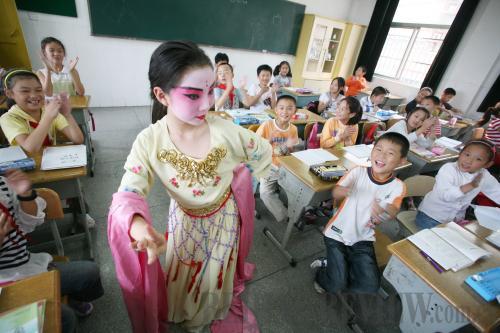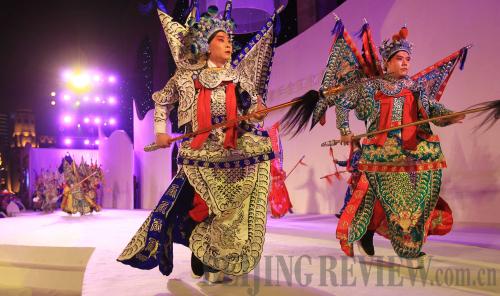|
 |
|
PASSING DOWN: Primary school students in east China's Jiangsu Province receive education on Peking Opera (GU JUN) |
Although he was not the first person to perform Peking Opera overseas, he is the first to make Western art circles sit up and take notice of China's traditional opera and recognize it as an art form in its own right. The year 2010 marks the 80th anniversary of the great cultural event when Mei performed Peking Opera in the United States.
"It's very important for traditional culture to 'go out.' The essence of foreign art floods into China and our national opera should also go out. In that way can we have mutual communication and learn from each other. It could also bring about a boom in China's culture industry," said Mei Baojiu, the maestro's youngest son, a prominent Peking Opera actor and also head of Mei Lanfang Peking Opera Troupe. He said the popularization of traditional culture should focus on primary education about Peking Opera for children.
More efforts are now being made to protect and develop Peking Opera in the country. The Beijing Municipal Bureau of Culture will host a series of activities such as performing, selecting new talent and holding forums about Peking Opera from November 2010 to February 2011. The successful listing will also promote further development of the art form. The Beijing Municipal Bureau of Culture, for example, will give preferential treatment to Peking Opera inheritors, which means these inheritors will receive a 20,000 yuan ($2,941) subsidy each year from 2010 to 2014. And a digital Peking Opera database is now being planned.
In addition, from 2011 to 2013, the China Peking Opera Museum will be constructed at an investment of up to 30 million yuan ($4.4 million).
An ABC of Peking Opera
Peking Opera, which originated in the late 18th century, is a synthesis of stylized action, singing, dialogue and mime, acrobatic fighting and dancing to represent a story or depict different characters and their feelings. As a harmonious combination of Grand Opera, ballet and acrobatics, it also presents the audience with an encyclopedia of Chinese culture through unfolding stories, beautiful paintings, exquisite costumes and martial arts. It is the most influential and representative of all operas in China.
In Peking Opera, there are four main types of roles: sheng (male), dan (young female), jing (painted face, male) and chou (clown, male or female). The characters may be loyal or treacherous, beautiful or ugly, good or bad, their images being vividly manifested.
Peking Opera can be divided into two different types characterized by singing or martial activities featuring acrobatics and stunts. Some repertoires are a combination of both. It has chang (singing), nian (dialogue), zuo (acting) and da (martial arts) as its basic performing forms. Generally speaking, every sound is sung, every move is danced, no realistic interpretation is allowed and no real-life apparatus or tools are allowed on the Peking Opera stage.
The artists start training at a very early age to master the required skills. Operatic dialogues and monologues are recited in Beijing dialect, and some of the words are pronounced in a special fashion unique to the opera. Melody with its harmonious rhythms has a graceful quality.
The colorful costumes are hand-embroidered using traditional Chinese patterns, resulting in garments of high aesthetic value.
 |
|
REAL KUNGFU: Peking Opera performer demonstrates martial art (LI MINGFANG) |
One of the most well-known aspects of Peking Opera is the facial make-up, which is rich and varied, depicting different characters and remarkable images. For example, a red face usually depicts heroic bravery, uprightness and loyalty; a white face symbolizes a sinister, treacherous and guileful character and a green face connotes surly stubbornness, impetuosity and lack of self-restraint.
Major Theaters for Peking Opera in Beijing
Mei Lanfang Grand Theater
Named after maestro Mei Lanfang, it was constructed on November 11, 2007. The theater is the first specially designed for Peking Opera performances in the capital.
Address: 8 Fuchengmen North Avenue, Xicheng District, Beijing, China
Tel: 86-10-58519688
Huguang Assembly Hall
The Huguang Assembly Hall dates back to the Qing Dynasty (1644-1911). It was an official's house during the Qianlong Emperor's reign (1735-1795) and was donated for use as an assembly hall in 1807. Decoration is tidy and graceful. The hall was once used to hold banquets for high society. Now it has been converted to the Beijing Opera and Drama Exhibition Hall and holds stage performances.
Address: 3 Hufang Road, Xicheng District, Beijing, China
Tel: 86-10-63518284
Zhengyici Peking Opera Theater
Zhengyici Peking Opera Theater is one of the best-known Peking Opera theaters. It is also one of the oldest wooden theaters in China. It has a long history dating back to 1688, and was reopened in October 2010.
Address: 220 Qianmen Xiheyan Road, Dongcheng District, Beijing
Tel: 86-10-63189454, 63151650 | 